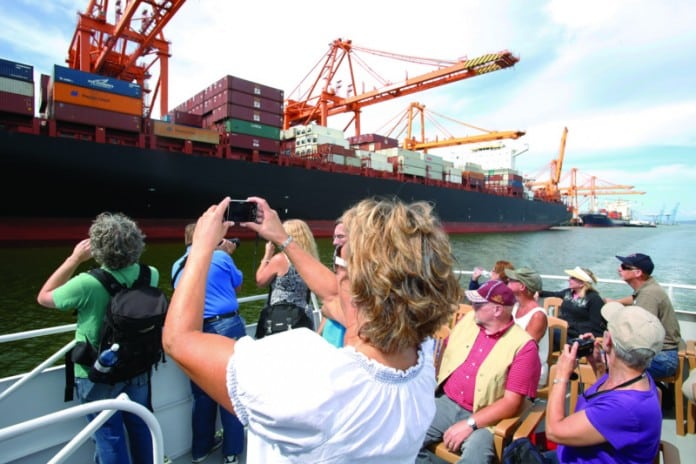International trade through Commencement Bay started long before the Port of Tacoma officially formed as a way to overssee and organize the shipping operations in Tacoma.
While the siting of the transcontinental railroad might hold the historical nod as the singular event that created the City of Destiny, it was the water that started it all.
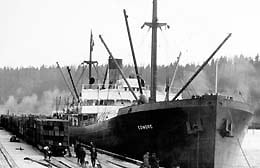
Courtesy Port of Tacoma. Photo courtesy: Port of Tacoma.
Nicholas Delin, a Swedish immigrant with sights on a new life in the Wild West, is credited with starting the city’s ties to the sea. He built a sawmill in 1852 at what is now the corner of Dock Street and Puyallup Avenue. The first load of lumber set sail for San Francisco lumberyards just months later. But it wasn’t for almost another 20 years that the first recorded transnational voyage was recorded. That distinction goes to a fleet of French ships that picked up a load of lumber in 1871 to then sell in Peru.
Focus from water routes to train travel, however, put shipping out of the spotlight in 1873, when the Northern Pacific railroad laid its tracks into Tacoma, making the City of Destiny the quite literal “end of the line” for transcontinental rail travel. But the call of the sea didn’t fade long, ships still shuttled lumber to California and brought goods back to the area on their return trips. As Asia became more open, so too did Tacoma’s ties with the Pacific Rim.
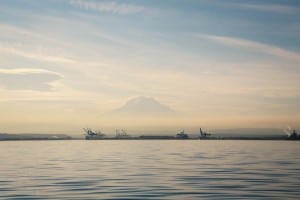
The Isabel holds the distinction as the first cargo of tea from China and Japan to call to port in Tacoma. The date was August 16, 1885. The ship arrived at 3:00 a.m. that morning. People on shore cheered as the sails appeared on the horizon. The cargo didn’t stay long, however. The 2,000 tons of tea were offloaded from the ship and loaded onto 200 rail cars bound for customers in New York. The trip took a month and was only made possible by the railroad deeply slashing its costs in hopes of teasing away customers from shipping companies. The battle between rail and sea traffic was on, putting Tacoma in the center since it had both. Water and rail traffic through Tacoma soared, and the city boomed in the 1880s. The city of just 1,000 residents in 1880 mushroomed to 36,000 a decade later.
But the waterborne boom had an economic hiccup as the 1880s ended. The city’s heavy dependency on international trade showed its dark side in the financial crash of the mid-1890s. Booms would follow busts and bring booms again as demand for local lumber around the nation made Tacoma “The Lumber Capital of the World.”
All through those early years, the moneyed Tacomans sought ways to shield themselves from the wild swings of the market by forming a port district to fund shipping wharfs and terminals. The first vote to create a Port of Tacoma came on November 5, 1912. It failed by 395 votes. The farm folks in Eastern Pierce County wanted no part of taxing themselves to help city folks in Tacoma.
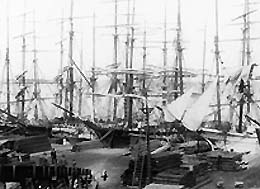
It wasn’t until 1919 that voters gave their nod to the formation of the Port of Tacoma with a $2.5 million bond to buy land on the waterfront and being construction of a municipal pier.
The Port of Tacoma formally began commercial shipping on March 25, 1921. On that day lumber haulers loaded 600,000 board feet onto the Edmore in just 24 hours. It was a world record. That success brought other ships and caused a need for immediate expansion.
The 1920s ended with more than two dozen shipping lines from around the world reguarly calling to port in Tacoma. But true to history, the boom was not to last. The Great Depression hit and the tideflats went largely quiet again, only to spark up with shouts of labor unrest between the shipping companies and the longshoremen in 1934, which saw an 85 day strike along the West Coast. The economic slow down also allowed the port to create an Industrial Development District and Waterway on the tideflats to enter into the landlord business as a way to diversify its revenue streams away from just shipping traffic.
Then World War II started.The boom years during the war busted again with the unconditional surrender of Germany and Japan in 1945. The Todd Pacific Shipyard, for example, had launched 74 warships from Tacoma and employed 30,000 people during the war, only to strip down to a skeleton crew once peace was declared.
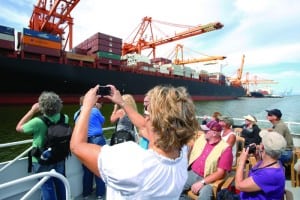
The port saw labor unrest and investments in its infrastucture as it sought to find its post-war footing. Lumber and grain still flowed through local waters, but levels were never what they were during the war years. The 30-year trade embargo of China ended in 1979, marking the first spike in trade with Pacific Rim nations.
By the 1980s, the port had tripled tonnage-moved and quadrupled revenues over the levels it had in the 1970s. Totem Ocean Trailer Epress had shifted its headquarters from Seattle to Tacoma in 1979, marking the move that would make Tacoma the main shipping route to Alaska. Mazda would start importing its cars through Tacoma the following year. Shipping traffic through Tacoma boomed and brought construction of terminals to keep up through the 1980s and early 2000s. Port of Tacoma and Port of Seattle merged much of their administrative functions in 2015 to become the Northwest Seaport Alliance as a way to coordinate waterway improvements and shipping traffic under a sign effort. The alliance now oversees the third largest shipping operation in the nation.
The Port of Tacoma remains a “Pacific Gateway” for trade between Asia and the central and eastern United States and Northwest as well as the lifeline for retail goods and food for Alaska.


































